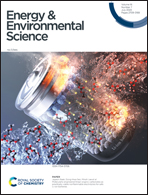Performance-limiting formation kinetics in green water-processed perovskite solar cells†
Abstract
Water is the most sustainable and environmentally friendly solvent in material synthesis. Perovskite prepared from a water solvent-based precursor (Pb(NO3)2/H2O) has been confirmed to be highly preferred and promising. Unfortunately, the sluggish conversion of Pb(NO3)2 to perovskite results in morphological flaws and incomplete transformation, which severely limit its photovoltaic performance. In this study, halide-free aqueous nanofluids (NFs) are prepared to regulate the formation kinetics of a perovskite via a grain refinement strategy. The crystallization process is examined by in situ UV-Vis absorption/PL measurements. It is found that both the microstructure of PbI2 and anion configurations play a key role in the formation kinetics. Consequently, PbCO3 NFs with an inert carbonate anion (CO32−) are carefully selected to promote the reaction rate by ∼30%. Moreover, CO32− effectively inhibits the formation of FA vacancy defects at the surface of a nearly pure FA-based perovskite. The device made from PbCO3 NFs in a fully dry-air atmosphere achieves an average PCE of 23.64% and a stabilized PCE of 23.95%. The bare device without any protection shows outstanding stability under continuous light illumination.



 Please wait while we load your content...
Please wait while we load your content...